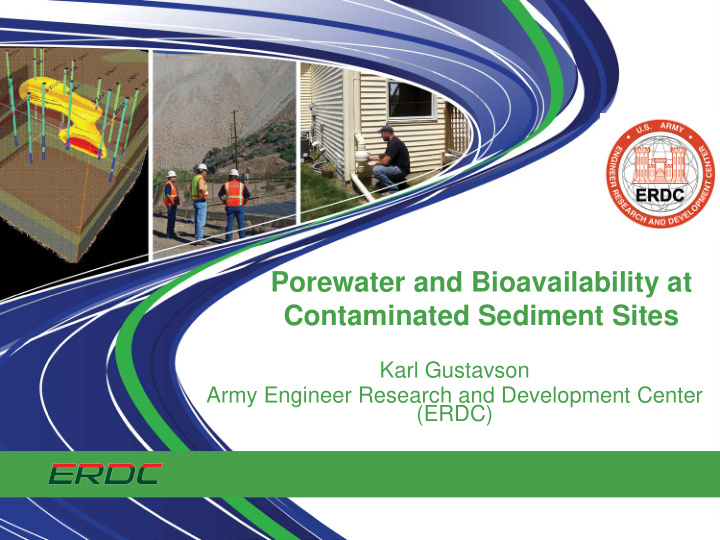



Porewater and Bioavailability at Contaminated Sediment Sites Karl Gustavson Army Engineer Research and Development Center (ERDC)
Outline Problem definition Porewater, bioavailability, and exposures Passive samplers for porewater assessment Passive sampler applications and environments Recommendations for use 2
Sediment Remediation Conducted to Conducted to decrease risk to decrease risk to consumers of fish. benthos. 3
Sediment – Biota Relationship There is a complex relationship between sediment and biota contamination. …influenced by concentration, bioavailability, fish diet, behavior, movement, etc. Magar et al. 2009 4
Sediment – Contaminant Dynamics All sediments aren’t created equal… they vary in potential to drive contaminant uptake. Magar et al. 2009 Gosh 2003 5
Terms Porewater (interstitial water) Water residing in the pore space of sediments. USGS.gov Alexander, 2000. ES&T 34: 4259-4265. Bioavailability The individual physical, chemical, and biological interactions that determine exposure of organisms to chemicals associated with soils and sediments. 6
Bioavailability Driving Exposures and Effects “Only a portion of the sediment-bound contamination is bioavailable, and there is no simple way of determining the available fraction through the use of extractants” “For several kinds of pollutants the interstitial water fraction has been shown to be most available to the benthos” (Swartz and Lee, 1980) Landrum 1989, ES&T 23:588 DiToro 1991, ET&C 10:1541 7
Bioavailability Driving Exposures and Effects Lack of concordance between toxicity and bioaccumulation and contaminant concentrations in bulk sediment. 8
Using EqP with lit. Koc and sediment PAH-34 grossly over-predicts mortality, and does not separate toxic from non-toxic sediments. Courtesy of Steve Hawthorne, Univ North Dakota 9
The two carbon (Koc/K BC ) model and sediment PAH-34 grossly under-predicts mortality, and does not separate toxic from non-toxic sediments. Courtesy of Steve Hawthorne, Univ North Dakota log K BC =0.6997 log Kow + 2.822, Koelmans, 2006 10
Measured freely-dissolved PAH-34 greatly improve mortality predictions, while still being conservative. Courtesy of Steve Hawthorne, Univ North Dakota 11
PCB-18 (2,2’,4) 5.56 4.95 4.95 Log Kow: 5.24 Compared to Koc of : 4.47 6.10 7.47 a) Traffic soot b) Oil soot c) Wood soot d) Coal soot e) Coal f) Charcoal g) Flyash h) Activated 4.15 8.16 5.88 carbon i) Graphite Jonker and Koelmans. 2002 12
Variation in Contaminant Partitioning Hawthorne et al. 2011 13
Porewater Sampling Importance long recognized. Variety of techniques: squeezing, centrifugation, leaching, filtering, direct sampling Issues • sampling altering chemistry • including DOC- and POC-associated contaminants Need to measure freely-dissolved fraction More detail in Mark Cantwell’s Presentation Sayles et al. 1976 14
Passive Samplers •Accumulate freely-dissolved organic contaminants from surrounding water into a solid phase. •Contaminant concentrations of the samplers are measured. •Circumvent problems associated with colloids, rapid- and slow- desorbing contaminants, and accounting for carbon content and variation. Passive Sampler Graphic: Rob Burgess, EPA-ORD 15
Diversity of Passive Samplers SPMD SPME PED semi-permeable membrane devices solid phase microextraction polyethylene device POM polyoxymethylene samplers
Prediction of Dissolved Concentration “Equilibrium” Sampling (ng/mL Passive Sampler) Concentration Deployment Time (days) C passive sampler C dissolved = K passive sampler/water 17
Quantification of Dissolved Concentration “Depletive” Sampling SPME Fiber ~1.5 mL Courtesy of Joseph Kreitinger, USACE porewater 18
Water Column Contaminant Analysis 19
Area Total DDx (ng/L) North Harbor 0.2 South Harbor 1.5 Nearshore (SF-12) Not recovered North Harbor Conventional Sampling was Non-detect “Freely dissolved” DDx concentration in surface water. Nature and Extent Relative Contamination Exposure Nearshore (SF12) Assessment Inclusion in food web modeling South Harbor (SH) South Harbor 20
Use of Passive Samplers in Cap Performance Monitoring In-situ SPME Samplers and Associated Cores D. Reible, Texas Tech University 21
PAH Profiles through Isolation Cap Cap profile shows performance as expected (isolation) 22
PAH Profiles through Isolation Cap Evidence of recontamination 23
Use of Passive Samplers in Cap Performance Monitoring Freely-dissolved PAH profiles through cap Nature and extent Changes over time Cap performance Recontamination Source ID D. Reible, Texas Tech University 24
Surrogates for Aquatic Organisms? TRANSFORMATION UPTAKE ELIMINATION GROWTH DILUTION Aquatic organisms vary in their interaction with the environment and physiology • Gradient from sessile to highly mobile • Large differences in food preference and feeding behavior • Gradient from poor metabolizes (e.g., mussels) to efficient biotransformers (e.g., fish from contaminated environments) 25
Benthic Invertebrate Feeding Strategies Al Kennedy, USACE ERDC Rhoads 1974 26
Variability in Bioaccumulation Potential Comparison of Di 8 Tri Tetra PCB uptake among Penta Hexa 6 Hepta-Nona organisms with Total BSAF different feeding 4 strategies. All organisms 2 exposed to the 0 same PCB- s s a a a contaminated sediment. Lotufo, USACE ERDC 27
Where Porewater/Bioavailability Assessments are Useful? Where bulk sediment concentrations aren’t sufficient. To define Nature and Extent of Contamination Concentration-Toxicity Relationships Definining Exposure Concentrations • “Truly-dissolved” pore- or surface-water • Flux from sediment bed Remedial Effectiveness Evaluations 28
Questions gustavson.karl@epa.gov 703-603-8753 29
Recommend
More recommend